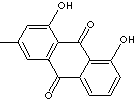|
CHRYSOPHANIC ACID |
| Synonyms. Chrysophanic acid; 1,8-Dihydroxy-3-methyl-9,10-anthracenedione; 1,8-Dihydroxy-3-methylanthraquinone; 3-Methylchrysazin; 4,5-Dihydroxy-2-methylanthraquinone; C.I. 75400; C.I. Natural Yellow 23; Chrysophanol; Turkey rhubarb; |
|
|
| PRODUCT IDENTIFICATION |
|
|
CAS RN |
481-74-3 |
|
EINECS RN |
207-572-2 |
|
FORMULA |
C15H10O4 |
|
MOLE WEIGHT |
254.24 |
|
H.S CODE |
2914.69.9000 |
|
SMILES |
c12c(C(c3c(cccc3C1=O)O)=O)c(cc(c2)C)O |
|
CLASSIFICATION |
Natural anthraquinone |
|
EXTRA NOTES |
Chrysophanic acid, a natural anthraquinone, is used to study anticancer activity in EGFR-overexpressing SNU-C5 human colon cancer cells. It is also used to study the inhibition of replication of poliovirus types 2 and 3 (Picornaviridae) in vitro |
|
|
| PHYSICAL AND CHEMICAL PROPERTIES |
|
|
PHYSICAL STATE. |
yellow powder |
|
MELTING POINT |
196 C |
|
BOILING POINT |
|
|
DENSITY |
|
|
SOLUBILITY IN WATER |
|
| SOLVENT SOLUBILITY | |
|
VAPOR DENSITY |
|
|
log P(octanol-water) |
4.49 |
|
VAPOR PRESSURE |
|
|
AUTOIGNITION TEMP |
|
| pH |
|
|
REFRACTIVE INDEX |
|
|
FLASH POINT |
|
|
|
| STABILITY AND REACTIVITY | |
| STABILITY | Stable under normal conditions. |
|
INCOMPATIBLE MATERIALS |
Strong Oxidizing agents |
| POLYMERIZATION |
Has not been reported |
|
NFPA RATINGS |
Health hazard: 0, Flammability: 0, Physical hazards: 0 |
|
|
| EXTERNAL LINKS & GENERAL DESCRIPTION |
|
Wikipedia Linking - Rhubarb Drug Information Portal (U.S. National Library of Medicine) - Chrysophanic acid PubChem Compound Summary - Chrysophanol KEGG (Kyoto Encyclopedia of Genes and Genomes) - Chrysophanol http://www.ebi.ac.uk/ - Chrysophanol http://www.ncbi.nlm.nih.gov/ - Chrysophanol http://www.mdpi.com/ http://umir.umac.mo/
|
|
|
| SALES SPECIFICATION |
|
|
APPEARANCE |
yellow powder |
|
ASSAY |
98.0% min |
| LOSS ON DRYING |
0.3% max |
| MELTING POINT |
194 - 198 C |
| HERB SOURCE | Rheum palmatum L. |
|
|
| TRANSPORT & REGULATORY INFORMATION |
|
|
UN NO. |
Not regulated |
| HAZARD SYMBOL |
|
| PACKING GROUP | |
|
|
| SAFETY INFORMATION |
|
|
HAZARD OVERVIEW |
Not known |
|
GHS |
|
|
SIGNAL WORD |
Warning |
|
PICTOGRAMS |
|
|
HAZARD STATEMENTS |
H315-H319 |
|
P STATEMENTS |
P305-P351-P338 |
| EC DIRECTIVES |
|
| HAZARD CODES |
|
|
RISK PHRASES |
36/38 |
|
SAFETY PHRASES |
26-36 |
|
|
| PACKING |
|
|
|
|
| PRICE INFORMATION |
|
|

